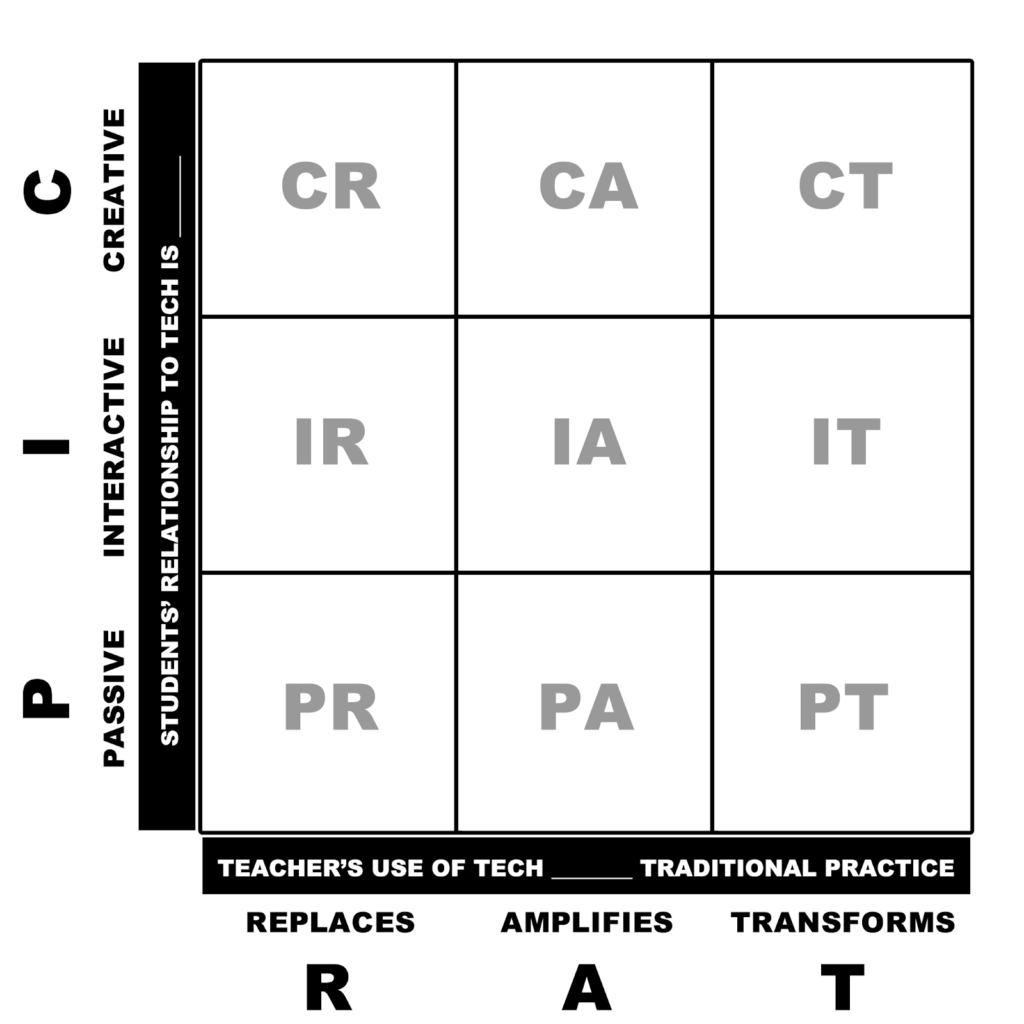A few years ago, a colleague suggested that I watch Simon Sinek’s TED Talk, which introduced me to the concept of identifying and communicating your why. To quote Sinek, “People don’t buy what you do, they buy why you do it.”
While there are many areas of one’s life that this principle could apply to, from personal or professional growth to goal-setting, I contend that this simple question, “why,” is one that practitioners and administrators have not had the luxury of asking themselves enough when it comes to the choices that we have recently had to make regarding classroom technology integration.
Thanks to a global pandemic, for many of us the “why” is simple: because our students need to learn in a virtual environment! We need to go deeper though. We need to look at instructional design decisions through this simple, yet powerful lens of “why?” In order to help teachers make more informed and purposeful decisions about what technology-based teaching and learning strategies they can and should use, many have benefitted from the use of a technology integration planning rubric, of which there are a number of iterations readily available. Additionally, administrators and instructional coaches can benefit from the utilization of many of these frameworks as they collaboratively reflect with teachers about instructional decisions in an attempt to improve their practice.
It started with SAMR
If you’ve been in education for a while, specifically those of you who have a penchant for technology integration, you are likely familiar with Ruben Puentedura’s SAMR Model, which provides a framework that educators can utilize in order to evaluate how they are integrating technology.
By “how,” what I mean is it allows one to reflect on the impact that the use of technology can have on the instructional activity itself. “How” does not necessarily mean “how well,” as so many variables can impact how well the concepts and skills are taught, transferred, and ultimately mastered.
This continuum spans the application gamut of mere substitution (S), meaning that the use of the technology is acting only as a digital substitution for a more traditional method of teaching and not really significantly improving it, to complete “redefinition” (R), where entirely new activities are designed to achieve the goal of the task and it would not be possible without technology. Some educators find this model a bit “fuzzy” as it can oftentimes be challenging to classify the application in the appropriate level or stage. Since Puentadura began his work nearly a quarter century ago, a number of other models have evolved that offer similar, yet different intricacies that you may find serve a more appropriate role.
Take Your “PIC”
One such model is the PIC-RAT matrix, which is built upon the RAT technology framework (Hughes, Thomas, & Scharber, 2006), that not only considers the effect on teaching, but also considers the impact on learning by identifying what students are actually DOING with the technology. Kimmons, Graham, and West designed this matrix in a way that is a bit more actionable as well as shares some parallels with Bloom’s Taxonomy.

This image is licensed under a CC BY 3.0 license by Dr. Royce Kimmons.
Using this matrix, the most effective uses of technology live in the top-right, that is, where the practice of the teacher is transformed and students are provided the opportunity to create evidence of their level of understanding, both of which were made possible by what technology affords us. Some examples of “top-right” technology integration would be allowing students to create websites, editing video, or other real-world digital artifacts that demonstrate problem solving. Like SAMR, it is not reasonable nor is it feasible to spend all of our time in CT, but if we stagnate in PR, we should not be surprised if we do not see significant changes in learning. Simply converring lectures to slide presentations or providing content-specific videos is not likely to result in sustainable growth.
Integrate with “E’s”
In my particular school district, we formed a cadre of teacher-leaders who performed a close examination of available evaluation tools and we decided that Liz Kolb’s Triple E Framework best fit our needs, from both the instructional design perspective as well as for the purpose of evaluation. When comparing it to PIC-RAT, we found it to be a bit easier to identify an instructional strategy in terms of the impact that it was potentially having on the student’s learning experience. Specifically, it allows users to articulate whether or not the activity was designed to engage learners, enhance instruction, and/or extend learning beyond the four walls of the classroom.

Within the domains, Kolb defines the characteristics of each as well as provides examples of the varying aspects. For example, in the Engagement domain, she defines the application of technology as one that is minds-on, active, and motivating. From there, an instructional designer would make decisions about technology uses that would best align with the goals, i.e. to motivate learners to begin and complete an activity or to shift from being a passive learner to one that is active. In practice, it can be daunting to choose applications of technology that always address all three domains, but it is certainly something to work towards.
The rubrics that are available, while also being useful in the planning process, can also be used as a constructive evaluation and reflection tool in the delivery phase of the activity. To use it as a punitive instrument to “catch” teachers not using technology the “right” way can only add to the anxiety of an already stressful environment. I contend that strong pedagogy and classroom leadership can be magnified by the integration of technology, but the opposite also holds true. If a teacher struggles with the fundamental concepts of what constitutes “good” teaching and learning, how he or she integrates technology can sometimes compound already existing issues. Using a framework to make more purposeful decisions about the role that technology should play in the classroom can provide a target that instructors can use to work towards focused growth.
So where do you go from here? In order to even begin to answer this loaded question, you really need to ask yourself “why?” Why are you integrating technology in the first place? What purpose do you hope that it serves? From my perspective, using a framework such as the Triple E, PIC-RAT, or any other technology integration evaluation and planning frameworks can potentially guide you along the path of making the best decisions possible in terms of aligning technology with larger desired outcomes. In my upcoming Keep Indiana Learning video series, we will examine more deeply these frameworks as well as provide some examples of instructional strategies, apps, and web resources that would align with the different domains of each.
Resources
Please login or register to claim PGPs.
Alternatively, you may use the PGP Request Form if you prefer to not register an account.



